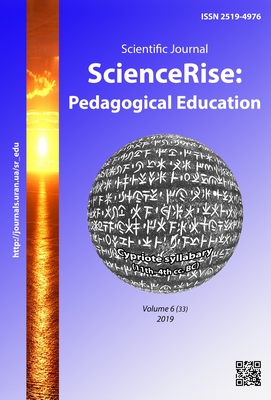Project method in developing competence in English writing of future teachers` of English: theoretical background and practical principles
DOI:
https://doi.org/10.15587/2519-4984.2019.185660Keywords:
linguistic higher educational institution, teaching English writing, project technologies, project work, methodological principlesAbstract
Having analyzed the research of foreign and domestic scientists who are dedicated to developing communicative competence in English writing, we have come to the conclusion that this kind of writing is often neglected in English language courses in higher education and teaching it frequently lacks efficiency and intensity due to the lack of elaborated teaching and learning technologies. The research, submitted for consideration, was an attempt to create an efficient and intensive technology for the needs of teaching English to future specialists in that language at Ukrainian higher educational institutions using project technology. Such technology is intended to be based on observing a whole range of specially developed methodological principles for developing the communicative competence in English writing of future teachers of English on the basis of project technologies. The research completed demonstrates that introduction of project technologies into teaching English writing at linguistic higher educational institutions, beginning with the second year of the student’s English studies, should be based on three main methodological principles and ten subordinated ones that will provide organizational background, independence of implementation of students` project work and optimization of teaching English writing
References
- Byrne, D. (1988). Teaching writing skills. London: Longman, 154.
- Tribble, C. (1996). Writing. Oxford: Oxford University Press, 174.
- Zhovnych, O. V. (2018). Metodyka navchannia profesiino oriientovanoho anhlomovnoho pysemnoho spilkuvannia maibutnikh zhurnalistiv zasobamy blohtekhnolohii. Kyiv, 260.
- Tarnopolsky, O. (2001). The scale of learner autonomy: Three levels in an intensive English program. Independence, 29, 2–5.
- Titova, V. V. (2001). Modulno-proektna metodyka navchannia anhliiskoi movy studentiv vyshchykh tekhnichnykh zakladiv osvity. Kyiv, 268.
- Kuprikova, S. V. (2013). Shliakhy realizatsii proektnoi metodyky pry navchanni inozemnoi movy. Pedahohichni nauky: teoriia, istoriia, innovatsiini tekhnolohii, 4 (30), 223–230.
- Medvedeva, L. I. (2011). Proektnaia metodika obucheniia inostrannomu iazykuv kontekste sovremennykh pedagogicheskikh tekhnologii. Naukovі zapiski. Serіia: Pedagogіka, 4, 129–133.
- Ustymenko, O. M. (2017). Proektna tekhnolohiia navchannia inozemnykh mov i kultur studentiv movnykh vyshchykh navchalnykh zakladiv. Inozemni movy, 2, 44–58.
- Piekhota, O. M., Kiktenko, A. Z., Liubarska, O. M. et. al.; Piekhota, O. M. (Ed.) (2002). Osvitni tekhnolohii. Kyiv: ASK, 255.
- Freire, P. (2013). Education for Critical Consciousness. London: Bloomsbury Academic, 168.
- Rogers, C. R. (1983). Freedom to learn for the 80s. Columbus: Charles E. Merrill Publishing Company, 312.
- Tarnopolskyi, O. B., Kozhushko, S. P. (2008). Metodyka navchannia studentiv vyshchykh navchalnykh zakladiv pysma anhliiskoiu movoiu. Vinnytsia: Nova knyha, 288.
Downloads
Published
How to Cite
Issue
Section
License
Copyright (c) 2019 Svitlana Storozhuk

This work is licensed under a Creative Commons Attribution 4.0 International License.
Our journal abides by the Creative Commons CC BY copyright rights and permissions for open access journals.
Authors, who are published in this journal, agree to the following conditions:
1. The authors reserve the right to authorship of the work and pass the first publication right of this work to the journal under the terms of a Creative Commons CC BY, which allows others to freely distribute the published research with the obligatory reference to the authors of the original work and the first publication of the work in this journal.
2. The authors have the right to conclude separate supplement agreements that relate to non-exclusive work distribution in the form in which it has been published by the journal (for example, to upload the work to the online storage of the journal or publish it as part of a monograph), provided that the reference to the first publication of the work in this journal is included.








